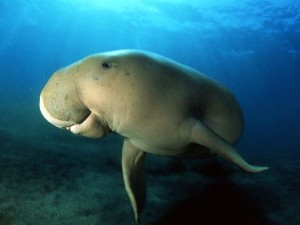Divers diligently discussing distressed dugongs; it’s a little more than a made-up tongue-twister. For a few crew from Passions of Paradise, Wednesday May 6 was a chance to learn about one of the Great Barrier Reef’s shyest and rarest inhabitants, the dugong. In a special workshop held by the Great Barrier Reef Marine Park Authority, local tourism crews had the chance to learn about threats to dugong and sea turtle populations from Professor Helen Marsh, Helene Marsh is Dean of Graduate Research Studies and Professor of Environmental Science at James Cook University and program leader in the Marine and Tropical Science Research Facility. The information session was followed by a Q&A as to how tourism crew can help monitor dugong and turtle populations at their dive sites and report relevant data.
Dugongs, or sea cows as they are sometimes called, are marine animals which can grow to about three metres in length and weigh as much as 400 kilograms, and are the only marine mammals in Australia that live mainly on plants. Australia is home to the largest population of dugongs in the world, stretching from Shark Bay in Western Australia to Moreton Bay in Queensland. Dugong play an important ecological role in coastal marine ecosystems, and the status of dugong populations in an area can be used as an indicator of general ecosystem health. While sightings on the Great Barrier Reef are rare, occasionally tourism staff encounter them closer to bodies of land, as the sea grass the dugong feed on tends to grow in the shallower, warmer waters near land.
Tourism staff have the unique opportunity to observe any dugong behaviour, as boat crews are by far and away the most frequent visitors to the reef. The Eye on the Reef program uses four reporting metrics as a way for tourism staff to help assess reef health and impacts; when a dugong is sighted, the most useful tool is Sightings Network. During the workshop, staff were shown how Sightings Network, now in the form of a smartphone app, can be used to report sightings of dugongs and other iconic species directly to the Marine Park Authority and scientists like Professor Marsh.
“I’d be very interested in any sighting, particularly mating and calving,” Says Professor Marsh, “I have only ever heard one reliable account of dugong calving behaviour; any sighting like that would be an invaluable piece of data collection.”
The Eye on the Reef system is by far the most valuable tool for assessing the health of selected reef tourism sites, and Passions of Paradise is a long-standing member of the program and has been recognised as a leader in reporting reef health, impacts, and sightings of iconic, threatened and indicator species. Additionally, the Sightings Network App is open to the public and allows anyone to submit sightings to the Marine Park Authority. These sightings needn’t be just wildlife related; visitors to the reef can report coral bleaching, suspected illegal activity, and other items they think may be significant. Anyone interested in the Sightings Network App can find more information at http://www.gbrmpa.gov.au/managing-the-reef/how-the-reefs-managed/eye-on-the-reef/report-sightings.
So, if you are heading out to the Great Barrier Reef as a first time visitor, avid fisherman, or tourism staff, we encourage you to download the free Sightings Network App and start logging what you see—it’s a great tool to help the Marine Park Authority monitor what is actually going on out on the GBR.
Remember: We have one reef, let’s take care of it!

